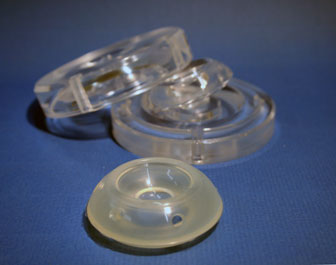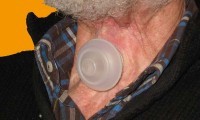Handsfree speech valve for laryngectomy patients, version 1
The successor to this version 1 automatic speech valve is the iValve v2
Without a larynx, and therefore without vocal cords, laryngectomy patients are basically unable to speak. Luckily, since years a little valve can be inserted between the trachea and the oesophagus through which – if patients shut the stoma in their neck with a finger – it is possible to exhale, into the oesophagus. The oesophagus then starts to vibrate, as with the regurgitation of air, and this noise functions as a new vocal cord. It is awkward for patients to always need to have a (clean) finger free, and the stoma uncovered in order to be able to close off the stoma. That’s why an automatic speech valve is in development that can be closed through strong inhalation. All the air that is subsequently exhaled is obstructed by the valve and thus transformed into sounds of speech. In this “speech mode” it is still possible to inhale through the valve. The valve “switches” into breathing mode again through a short, strong exhalation. Practical tests have already shown that speaking with this valve is well achievable. A follow-up valve that is (even) simpler in design and especially much smaller will be tested in the immediate future.
We are looking for companies that would perhaps like to produce and distribute this valve.
Aim: automatic – hands-free – speech for laryngectomy patients
Commissioned for: Improvement of hands-free speech for laryngectomy patients
Material: silicone rubber
Method of fabrication: low pressure moulded in a perspex casting mould
Particulars: Valve closes upon inhalation and consists of only two parts (and potentially also an air filter)
A report can be seen on the website of Gezond24.nl about a volunteer coming to test a prototype speech valve at the ENT clinic in the UMCG.





